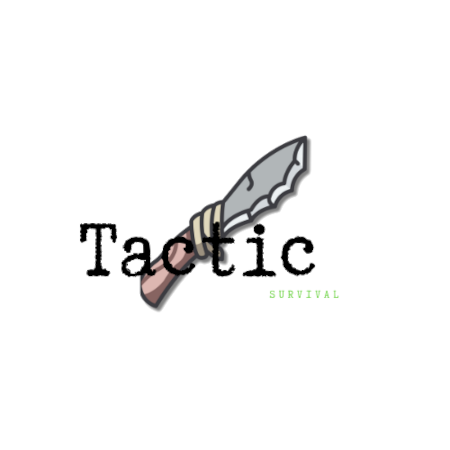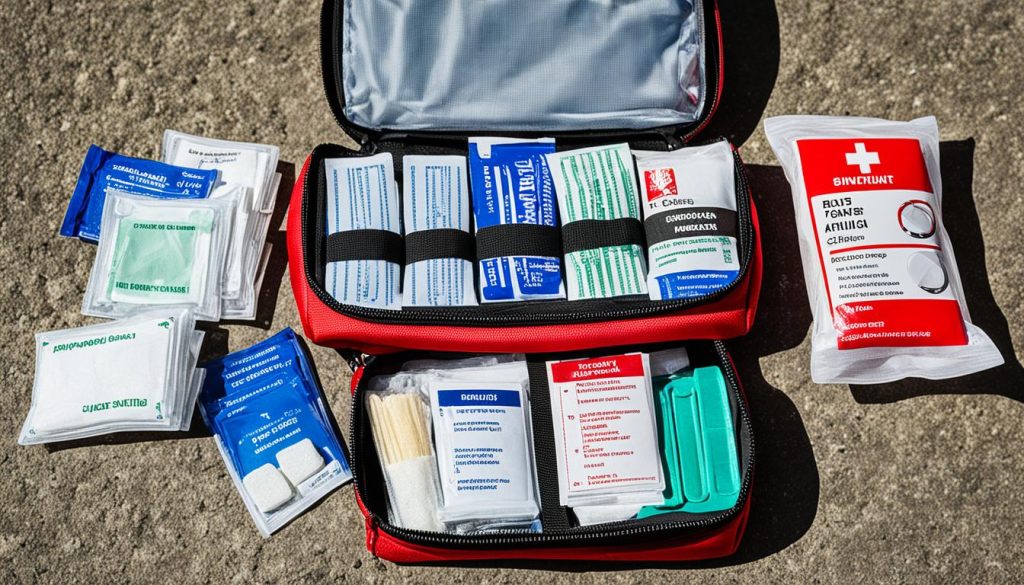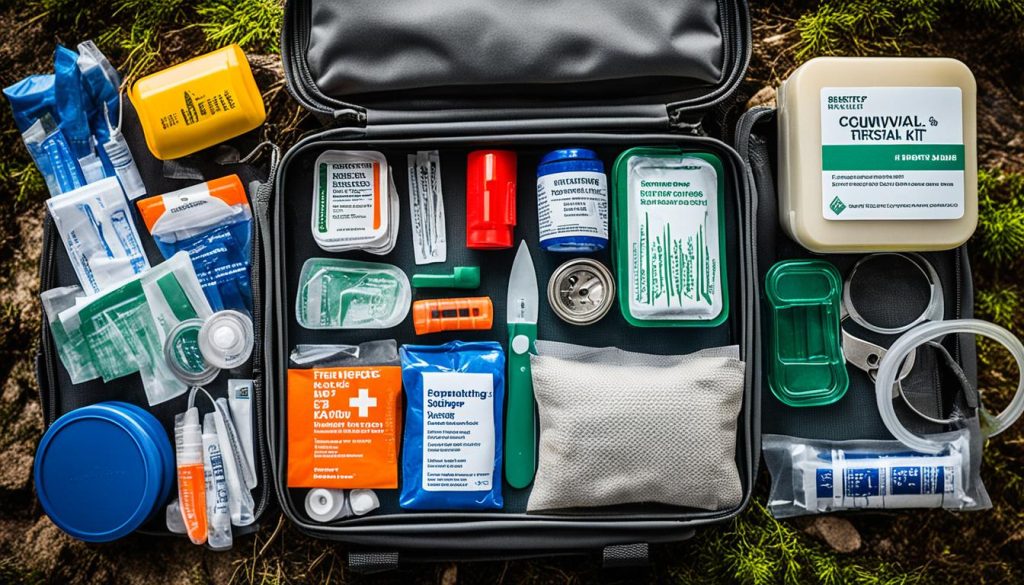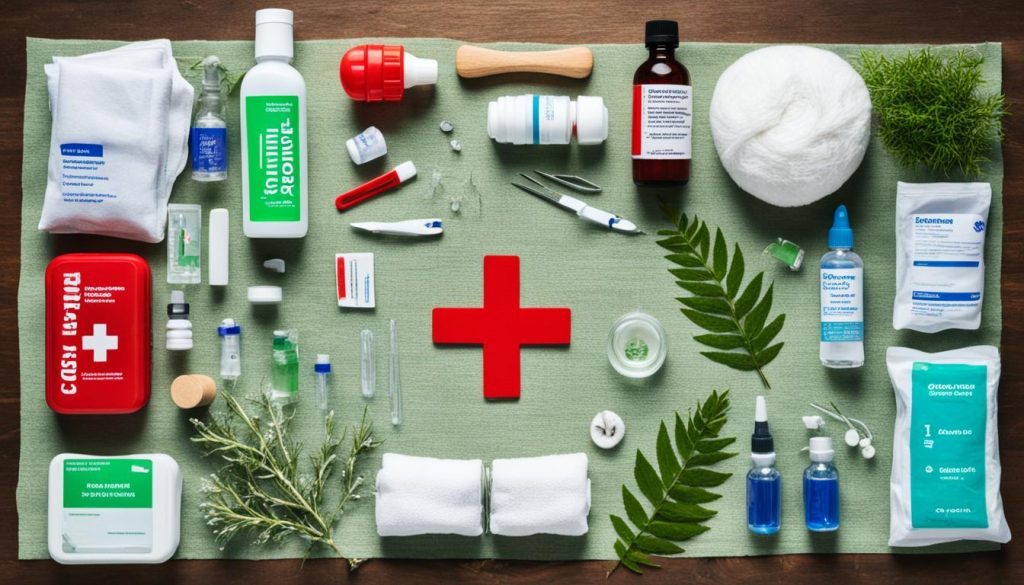Did you know that every year, millions of people worldwide find themselves in emergency situations while enjoying the great outdoors?
Whether it’s a hiking trip, camping adventure, or wilderness expedition, accidents can happen anytime, anywhere. Having a well-stocked survival first aid kit can make all the difference in handling injuries and emergencies efficiently.
From minor scrapes to more serious wounds, a properly equipped outdoor first aid kit can provide essential medical supplies to address a range of injuries until professional help arrives. But what exactly should you include in your survival first aid kit? Let’s explore the key items recommended by experts to ensure you’re prepared for any outdoor mishap.
Key Takeaways:
- A well-stocked survival first aid kit is crucial for outdoor adventures and emergency situations.
- Include items like dressings, bandages, ointments, and gloves to handle injuries effectively.
- Add personal items like medications and emergency phone numbers for comprehensive preparedness.
- Regularly check and replace expired or used supplies to maintain the kit’s readiness.
- With a comprehensive first aid kit, you’ll be equipped to handle emergencies with confidence.
How to Prepare for Emergencies
Being prepared for emergencies is crucial, and one of the most important steps you can take is to have first aid kits in various locations. Having a well-stocked and easily accessible first aid kit can make a significant difference in handling injuries and emergencies effectively. Here are some essential tips to help you prepare for emergencies:
Keep Kits in Multiple Locations
It’s important to keep a first aid kit in different locations to ensure you are always prepared. Consider having a kit at home, in your car, and even at your workplace. Emergencies can happen anywhere, and having a kit readily available in these key locations can be a lifesaver.
Purchase or Create Your Own Kit
You have two options when it comes to first aid kits: purchasing a pre-packaged kit or creating your own customized kit. Drug stores and online retailers offer a wide range of emergency medical kits to choose from, ranging from compact first aid kits to comprehensive emergency survival kits. Alternatively, you can gather the necessary supplies and create your own kit to tailor it to your specific needs and preferences.
Consider Activity-Specific Kits
Depending on your lifestyle and activities, it may be beneficial to invest in activity-specific first aid kits. For example, if you enjoy hiking, camping, or boating, you can find kits designed to address the potential injuries and emergencies associated with these activities. These kits often come equipped with specialized items like sunscreen, insect repellent, and blister treatment.
Include Personal Items and Regularly Check Contents
In addition to the standard first aid supplies, it’s essential to include personal items recommended by your healthcare provider. This may include prescription medications, allergy medications, or any other specific items based on your medical needs. Remember to regularly check the contents of your kit, replacing any expired supplies and restocking used items to ensure your kit is always up to date and ready for use.
Pro Tip: Keep a list of emergency phone numbers in each of your first aid kits, including local emergency services, poison control, and your healthcare provider. This will help you quickly access crucial information during an emergency.
By following these guidelines and being prepared, you can confidently handle emergencies and ensure the safety of yourself and others.
| Item | Description |
|---|---|
| Adhesive bandages | Various sizes to cover cuts and scrapes |
| Antiseptic wipes | To clean wounds and prevent infection |
| Antibiotic ointment | To prevent infection in minor cuts and wounds |
| Wraps and splints | For stabilizing fractures and sprains |
| Additional medications | Prescription medications, pain relievers, and allergy medications |
| Tools and supplies | Knife, scissors, tweezers, and a CPR mask |
Having a well-prepared emergency first aid kit is essential for any unexpected situation. Whether you purchase a ready-made kit or create your own, make sure it includes the necessary supplies, is easily accessible, and regularly maintained. By taking the time to prepare for emergencies, you can have peace of mind knowing that you are ready to respond effectively when faced with unexpected situations.
Packing a DIY Survival First Aid Kit
If you prefer to assemble your own survival first aid kit, there are several items you should include. Basic care supplies like adhesive bandages, antiseptic wipes, and antibiotic ointment are essential to treat minor injuries and prevent infections. These portable first aid supplies form the foundation of your kit, providing immediate relief and protection in emergency situations.
In addition to the basics, you’ll need to pack wraps, splints, and wound coverings to stabilize fractures, sprains, and deep cuts. These survival gear medical supplies are crucial when professional medical help is not immediately accessible.
It’s also important to include additional medications like antibiotics and pain relief medication to address more severe injuries. These portable first aid supplies help manage pain and fight potential infections, offering essential support in critical situations.
Various tools and supplies should be an integral part of your DIY survival first aid kit. A sharp knife and scissors come in handy when cutting clothing, bandages, or creating improvised medical tools. Tweezers are essential for removing splinters or foreign objects from wounds. Lastly, a CPR mask is crucial to perform cardiopulmonary resuscitation.
When packing your kit, consider the specific needs of your adventure or environment. If you’re venturing into the wilderness, you may need additional supplies like bear spray, snakebite kits, or an emergency whistle. Tailor your survival gear medical supplies to match the potential risks and hazards you may encounter during your outdoor pursuits.
Tips for Packing a DIY Survival First Aid Kit:
- Include basic care supplies like adhesive bandages, antiseptic wipes, and antibiotic ointment.
- Pack wraps, splints, and wound coverings to stabilize fractures, sprains, and deep cuts.
- Ensure you have additional medications like antibiotics and pain relief medication to address more severe injuries.
- Include essential tools like a knife, scissors, tweezers, and a CPR mask.
- Consider the specific needs of your adventure or environment and pack accordingly.
By packing a well-rounded and comprehensive DIY survival first aid kit with portable first aid supplies and survival gear medical supplies, you’ll be prepared to handle a wide range of emergencies and injuries.
Building a Comprehensive First Aid Kit
A comprehensive first aid kit is essential for handling a wide range of injuries and emergencies. In addition to stocking up on basic first aid supplies, it’s important to include specific items that can address different situations effectively.
Here are some key items that should be included in a comprehensive first aid kit:
1. Super Glue
Super glue can be a valuable addition to your first aid kit. It can be used to seal small cuts or wounds until you can seek proper medical attention.
2. Eye Shields
Eye shields provide protection for the eyes in case of injuries or chemical exposure. They should be included in your kit to safeguard against potential eye injuries.
3. Splints
Splints are essential for immobilizing and stabilizing fractures and broken bones. Include a variety of splints in your kit to cater to different sizes and types of injuries.
4. Instant Cold Packs
Instant cold packs offer a quick way to provide cold therapy for sprains, strains, or other injuries. These packs activate instantly when squeezed, providing instant relief.
5. Medications and Treatments
Include a range of medications and treatments in your first aid kit. These can include common over-the-counter medications like pain relievers, as well as specific medications prescribed by your healthcare provider. Don’t forget to include treatments for conditions like sunburn relief gel and cough and cold medications.
6. Tools and Supplies
A well-stocked first aid kit should also contain various tools and supplies. These can include paramedic shears for cutting clothing, medical gloves for protection, and a waterproof notepad for recording important information during emergencies.
By assembling a comprehensive first aid kit, you’ll be prepared to handle various emergencies and provide essential care when needed.
Stocking a Home First Aid Kit
It’s crucial to have a well-stocked first aid kit in your home. In addition to basic supplies like adhesive tape, bandages, and gloves, include items like nonstick sterile bandages, eye shields, and a thermometer. Stock medications like pain relievers, antacids, and antihistamines. Emergency items like emergency phone numbers, medical consent forms, and a small waterproof flashlight should also be part of your home kit. Regularly check and replace expired supplies.
When building your home first aid kit, consider the guidelines provided by Mayo Clinic. They recommend that your kit should include:
- Adhesive tape
- Bandages in various sizes and shapes
- Gauze pads and rolls
- Antiseptic wipes
- Tweezers and scissors
- Disposable gloves
- Nonstick sterile bandages
- Eye shields
It’s also important to keep a thermometer and over-the-counter medications such as pain relievers, antacids, and antihistamines. These medications can help provide relief for common ailments and minor injuries.
In case of an emergency, it’s vital to have essential emergency items readily available in your first aid kit. These include emergency phone numbers, medical consent forms, and a small waterproof flashlight. These items can assist you in managing situations that require immediate attention.
Regularly check your home first aid kit and replace expired supplies or items that have been used. By keeping your kit up-to-date, you’ll be prepared to handle any minor injuries or emergencies that may occur in your home.
Conclusion
Having a well-stocked survival first aid kit is crucial for any outdoor adventure or emergency situation. Whether you choose to purchase a pre-packaged kit or assemble your own, it’s important to include the necessary items to handle injuries and emergencies. Regularly checking and replacing expired or used supplies ensures that your kit is always ready to use.
A comprehensive first aid kit should include wilderness first aid supplies like dressings, bandages, ointments, and gloves, along with personal items such as medications and emergency phone numbers. If you prefer to create your own kit, consider packing portable first aid supplies, survival gear, and medical tools that cater to the specific needs of your adventure or environment.
By being prepared with a well-stocked outdoor first aid kit, you’ll have the peace of mind knowing that you can handle any emergency that comes your way. Stay safe and be proactive in your readiness. With the right supplies on hand, you can confidently tackle any outdoor challenge or unexpected situation.



